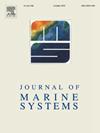Light absorption properties and absorption budget of the Black Sea
IF 2.5
3区 地球科学
Q2 GEOSCIENCES, MULTIDISCIPLINARY
引用次数: 0
Abstract
This study is focused on bio-optical data collected from deep parts of the eastern and western Black Sea and the Crimean shelf waters during nineteen cruises of RV “Professor Vodyanitsky” carried out in different seasons in 2015–2022. Based on a long-term data set, a parameterization of light absorption by phytoplankton (), non-algal particles (), and colored dissolved organic matter was performed. Parameterization coefficients for phytoplankton absorption were revealed for all seasons. A two-fold difference was observed in the chlorophyll “a” specific light absorption coefficient of phytoplankton in the Black Sea between summer and winter seasons. The difference was related to the “pigment package effect” resulting in the self-shading of pigments caused by changes in intracellular pigment concentration and phytoplankton cell size due to adaptation of phytoplankton to the varying environmental factors. The use of seasonal-specific coefficients of parameterization of phytoplankton light absorption provides more accurate retrievals of spectra based on the chlorophyll “a” concentration in modelling the light field and primary production using a spectral approach. The parameterization of CDOM light absorption and the revealed relationship between and spectral slope (SCDOM) allow one to correctly retrieve the based on the CDOM light absorption coefficient at particular wavelength. This is applicable both for data from submersible probes and for satellite data. Accurately retrieved CDOM spectra allow more correct modelling of the light field in the sea, which is crucial for waters, where CDOM is the main optically active component. Empirically assessed spectral slope of NAP absorption and share of NAP in particulate absorption allow to differentiate CDOM and NAP based on values of their summary absorption, which can be applicable for remote sensing data interpretation. The light absorption budget reveals CDOM as the main optically active component in the Black Sea upper layer (first optical depth). The parameterization of light absorption by all optically active components can be used to refine regional models for assessing water quality and productivity indicators based on remote sensing information.
黑海的光吸收特性和吸收收支
这项研究的重点是在2015-2022年不同季节进行的19次“沃达扬尼茨基教授”号游艇巡航中,从黑海东部和西部深处以及克里米亚大陆架水域收集的生物光学数据。基于长期数据集,对浮游植物(aphλ)、非藻粒子(aNAPλ)和有色溶解有机质(aCDOMλ)的光吸收进行了参数化。揭示了各季节浮游植物吸收的参数化系数。夏季和冬季黑海浮游植物叶绿素“A”比光吸收系数相差两倍。这种差异与浮游植物对不同环境因素的适应导致细胞内色素浓度和细胞大小发生变化,从而导致色素自遮光的“色素包效应”有关。利用浮游植物光吸收的季节特定参数化系数,在光场建模和光谱方法的初级生产中提供了基于叶绿素“a”浓度的更准确的aphλ光谱检索。CDOM光吸收的参数化和aCDOMλ与光谱斜率(SCDOM)之间的关系使得基于特定波长的CDOM光吸收系数可以正确地检索aCDOMλ。这既适用于潜水探测器的数据,也适用于卫星数据。准确检索的CDOM光谱可以更准确地模拟海洋中的光场,这对水域至关重要,因为CDOM是主要的光学活性成分。通过对NAP吸收光谱斜率和NAP在颗粒物吸收中所占份额的实证评估,可以根据CDOM和NAP的综合吸收值来区分它们,从而适用于遥感数据的解译。光吸收预算显示CDOM是黑海上层(第一光学深度)的主要光学活性成分。所有光学有效组分的光吸收参数化可用于改进基于遥感信息评估水质和生产力指标的区域模型。
本文章由计算机程序翻译,如有差异,请以英文原文为准。
求助全文
约1分钟内获得全文
求助全文
来源期刊

Journal of Marine Systems
地学-地球科学综合
CiteScore
6.20
自引率
3.60%
发文量
81
审稿时长
6 months
期刊介绍:
The Journal of Marine Systems provides a medium for interdisciplinary exchange between physical, chemical and biological oceanographers and marine geologists. The journal welcomes original research papers and review articles. Preference will be given to interdisciplinary approaches to marine systems.
 求助内容:
求助内容: 应助结果提醒方式:
应助结果提醒方式:


